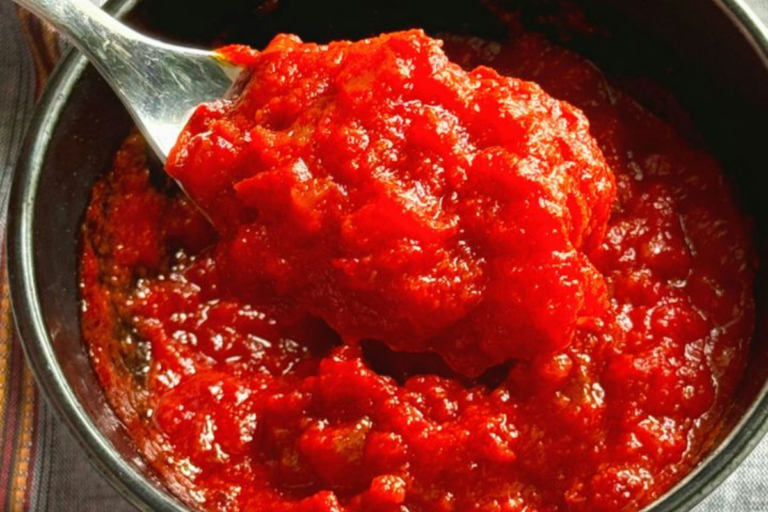Introduction
Tomato sauce is a versatile and classic condiment that is a staple in kitchens around the world. Made from ripe, juicy tomatoes and a blend of herbs and spices, this sauce is both flavorful and nutritious. Whether used as a base for pasta dishes, a topping for pizzas, or a dipping sauce for appetizers, tomato sauce adds a burst of tangy sweetness to any meal.
The Origin of Tomato Sauce
The history of tomato sauce traces back to Italy, where it is known as “salsa di pomodoro.” Originally, tomatoes were not widely accepted in European cuisine due to their resemblance to poisonous plants. However, by the 19th century, tomatoes became a key ingredient in Italian cooking, leading to the creation of the beloved tomato sauce we know today.
Varieties of Tomato Sauce
There is a wide range of tomato sauce varieties, including marinara, pomodoro, and arrabbiata, each with its unique set of ingredients and flavors. Some recipes call for fresh tomatoes, while others use canned tomato puree for convenience. Whether homemade or store-bought, tomato sauce can be customized to suit different palates and culinary preferences.
What Tools You’ll Need
Cooking Utensils
To prepare a delicious tomato sauce, you’ll require specific tools to ensure a smooth cooking process and a flavorful outcome. Here are the essential cooking utensils you need:
– Large saucepan
– Wooden spoon
– Cutting board
– Knife
– Immersion blender or regular blender
– Measuring cups and spoons
– Ladle
Cookware
Having the right cookware can significantly impact the quality of your tomato sauce. Here’s the cookware you should have on hand:
– Cooking pot or saucepan with a lid
– Saute pan
– Colander or strainer
– Heatproof bowl
Ingredients with Detailed Measurements
Main Ingredients
– 2 lbs ripe tomatoes, chopped
– 1/4 cup olive oil
– 1 medium yellow onion, diced
– 4 garlic cloves, minced
– 1 teaspoon salt
– 1/2 teaspoon black pepper
– 1 teaspoon sugar
To start making the tomato sauce, gather all the main ingredients in proper measurements. Begin by chopping 2 pounds of ripe tomatoes. Dice a medium yellow onion and mince 4 garlic cloves for added flavor.
Additional Ingredients
– 1/4 cup fresh basil leaves, chopped
– 1/4 teaspoon red pepper flakes
– 1 tablespoon balsamic vinegar
– 1/2 cup chicken or vegetable broth
– 2 tablespoons tomato paste
Incorporate extra layers of taste with 1/4 cup of fresh basil leaves and a pinch of red pepper flakes. Enhance the sauce’s depth with 1 tablespoon of balsamic vinegar and 1/2 cup of chicken or vegetable broth. Finally, add richness and thickness with 2 tablespoons of tomato paste.
Instructions
To make delicious tomato sauce, follow these simple steps:
Gather Ingredients
1. Heat olive oil in a saucepan over medium heat.
2. Add chopped onions and garlic, sauté until they are soft and translucent.
3. Pour in crushed tomatoes, tomato paste, and seasonings like salt, pepper, and dried herbs.
4. Stir the mixture well to combine all the ingredients.
Cook and Simmer
1. Bring the sauce to a gentle boil, then reduce the heat to low.
2. Let the tomato sauce simmer uncovered for at least 30 minutes, stirring occasionally.
3. Taste and adjust the seasoning as needed.
4. If you prefer a smoother consistency, use an immersion blender to puree the sauce.
5. Simmer for an additional 10-15 minutes to let the flavors meld together.
Finally, your homemade tomato sauce is ready to be used in your favorite pasta dishes, pizzas, or as a dipping sauce for appetizers. Enjoy the rich and flavorful taste of your freshly made tomato sauce!
Nutrition Score
Tomato Sauce is not just a flavorful addition to dishes, but it also packs a nutritional punch. Understanding the nutrition score of tomato sauce can help you make informed decisions about your diet and overall health.
Nutrient Content
Tomato sauce is a rich source of essential nutrients that are beneficial for the body. Some key nutrients found in tomato sauce include:
- Vitamin C: Known for its antioxidant properties, vitamin C helps boost the immune system and promote healthy skin.
- Potassium: Essential for maintaining proper fluid balance, potassium also plays a role in muscle contractions and nerve signals.
- Fiber: Tomato sauce is a good source of dietary fiber, which can aid in digestion and help you feel full longer.
- Lycopene: This powerful antioxidant is responsible for the vibrant red color of tomatoes and is believed to have various health benefits, including reducing the risk of certain chronic diseases.
With these nutrients, tomato sauce can be a valuable addition to a balanced diet.
Caloric Value
In terms of caloric content, tomato sauce is relatively low, making it a suitable option for those looking to manage their weight. A typical serving of tomato sauce contains around 50 calories, depending on the brand and added ingredients. This low-calorie count makes it a great choice for incorporating flavor into meals without significantly increasing overall caloric intake.
Serving & Storage
After preparing the delicious tomato sauce, it’s important to consider the best ways to serve and store it to maintain its freshness and flavor.
Serving Suggestions
Enhance your dishes with the versatile tomato sauce using these serving ideas:
– Serve over al dente pasta for a classic spaghetti dish.
– Use as a base for homemade pizza, spreading a generous amount on the dough.
– Drizzle over meatballs for a savory and saucy addition.
– Add to soups or stews to bring a rich tomato flavor to your recipes.
Transform your meals with these creative ways to incorporate tomato sauce!
Storage Tips
Proper storage is key to preserving the tomato sauce’s taste and quality:
– Allow the sauce to cool completely before storing.
– Transfer leftovers to an airtight container to prevent exposure to air.
– Store in the refrigerator for up to 4-5 days to maintain freshness.
– For longer storage, freeze the sauce in freezer-safe containers for up to 3 months.
By following these storage tips, you can enjoy the delicious tomato sauce for an extended period without compromising on taste and freshness.
Variations
1. Herb-Infused Tomato Sauce
– Enhance the flavor profile of your tomato sauce by infusing it with fresh herbs such as basil, oregano, thyme, or rosemary during the cooking process.
– Add the herbs to the sauce near the end of the cooking time to preserve their fresh aroma and taste.
– Remove the herb sprigs before serving to prevent an overpowering herbal flavor.
2. Chunky Vegetable Tomato Sauce
– Create a heartier version of tomato sauce by adding diced vegetables like bell peppers, zucchini, eggplant, or mushrooms.
– Sauté the vegetables before incorporating them into the sauce to enhance their flavors and textures.
– This variation adds a rustic and wholesome element to the sauce, perfect for serving over pasta or as a topping for crostini.
Mixing up the ingredients in your tomato sauce can provide a diverse range of flavors and textures. Experimenting with herb infusions or adding chunky vegetables can elevate your dish from ordinary to extraordinary. Whether you prefer a traditional recipe or a more creative twist, these variations offer delicious options to suit any palate.
FAQs with Most Commonly Asked Questions
1. How Can I Make Tomato Sauce from Scratch?
– Start by sautéing onions and garlic in olive oil.
– Add fresh tomatoes, tomato paste, herbs, and seasoning.
– Let the mixture simmer until it thickens, then blend until smooth.
2. Can Tomato Sauce Be Frozen?
When properly stored in airtight containers or freezer bags, tomato sauce can be frozen for up to 3 months. Thaw in the refrigerator before using.
Here are some common questions about tomato sauce:
– How long can tomato sauce be stored in the fridge?
– Can tomato sauce be canned at home for long-term storage?
– What is the difference between tomato sauce and marinara sauce?
– Is tomato sauce gluten-free?
Conclusion
Tomato sauce, a versatile and flavorful staple in many cuisines, adds depth and richness to a wide variety of dishes. Whether used as a base for pasta, pizza, or stews, its tangy sweetness enhances the overall taste profile.
Enhancing Flavor Profiles
By slow cooking tomatoes with aromatics and herbs, the sauce develops layers of flavors that intensify with time. The caramelization of sugars in tomatoes creates a slightly sweet undertone, while the acidity cuts through richness, balancing the dish.
Transitioning towards a robust taste, tomato sauce infused with garlic, onions, and fresh herbs creates a savory depth that elevates simple dishes like pasta to gourmet status.
Versatile Culinary Application
From classic spaghetti Bolognese to hearty vegetable stews and shakshuka, tomato sauce proves its adaptability across different cuisines. It serves as a canvas for experimenting with additional ingredients, accommodating personal preferences and dietary restrictions.
Transitioning from traditional uses to more contemporary interpretations, tomato sauce can also be the base for unique dishes like tomato braised chicken or eggplant parmesan.
In conclusion, tomato sauce is not just a condiment but a cornerstone of many beloved recipes, offering a delicious way to enjoy the bountiful harvest of ripe tomatoes throughout the year.

